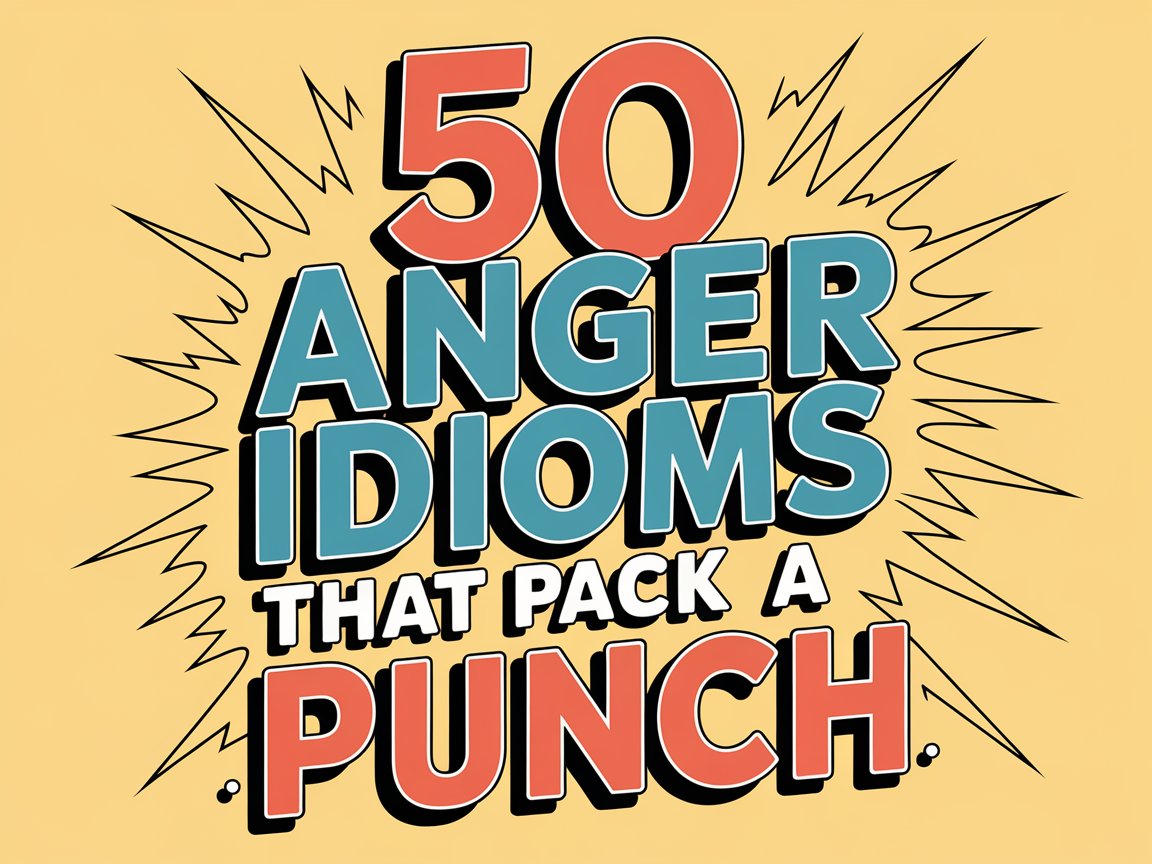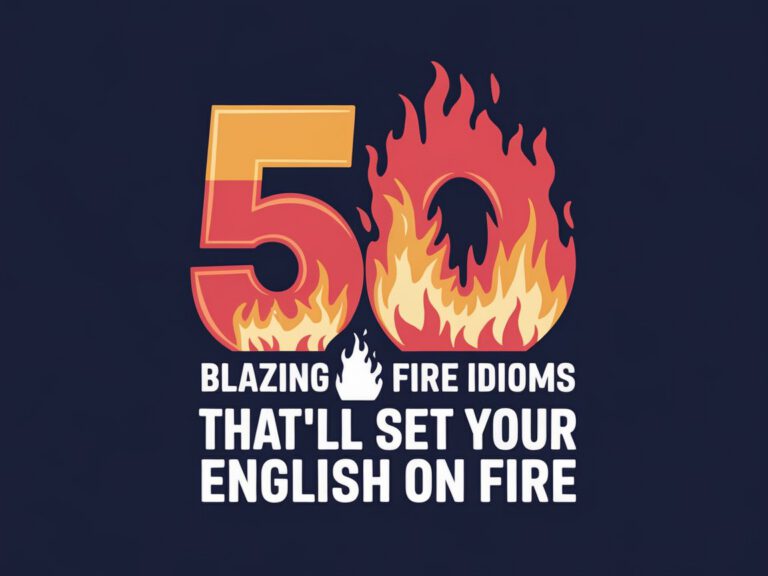50 Anger Idioms That Pack a Punch

Have you ever felt so angry that regular words just didn’t cut it? You’re not alone. English is packed with colorful idioms that capture the fiery, explosive nature of anger better than any plain description ever could. These 50 anger idioms will transform how you express frustration, rage, and annoyance.
Building Trust Through Research
Research from cognitive linguistics shows that anger idioms are primarily structured around metaphorical mappings where ANGER is conceptualized in terms of MOTION and HEAT. According to a comprehensive study published in Contemporary Issues in Language, the analysis of 37 anger idioms revealed that “it is the MOTION element which plays the crucial role in the conceptualizations of ANGER in idioms in English.”
“The vast majority of the metaphorical idioms seem to fit a common pattern… It is the MOTION element which seems to be the most prominent aspect of the conceptualisation” – Contemporary Issues in Language Study
| Anger Idiom Categories | Examples | Metaphorical Basis |
|---|---|---|
| Heat-Based | “Seeing red,” “Hot under the collar” | ANGER IS HEAT |
| Motion-Based | “Blow a fuse,” “Fly off the handle” | ACTIVITY IS MOTION |
| Container-Based | “Blow your top,” “Hit the roof” | PERSON IS CONTAINER |
| Animal-Based | “Like a bull in a china shop,” “Mad as a wet hen” | ANGER IS WILD BEHAVIOR |
The Science Behind Anger Expressions
Before diving into our comprehensive list, let’s understand why these idioms exist. Psychology Today notes that emotional intelligence research shows that people who can articulate their anger effectively manage it better. These idioms aren’t just colorful language—they’re tools for emotional regulation.
Pro-Tip: Using specific anger idioms instead of just saying “I’m mad” helps you communicate the exact intensity and type of anger you’re feeling. This precision actually helps defuse situations faster.
50 Anger Idioms: From Simmering to Explosive
Level 1: Mild Irritation (1-10)
1. Hot Under the Collar When someone’s getting annoyed but hasn’t exploded yet. Your boss might be hot under the collar about the late report, but they’re keeping it professional.
2. Get Off My Back This means “stop bothering me” or “leave me alone.” It’s what you say when someone’s constant nagging is pushing your buttons.
3. Riled Up Picture a calm pond that someone just threw a stone into. That’s what being riled up feels like—disturbed and agitated.
4. Work Someone’s Last Nerve When someone’s patience is hanging by a thread. That one coworker who chews loudly is working your last nerve.
5. Get Under Someone’s Skin This idiom captures that annoying feeling when something bothers you more than it should. It’s like a persistent itch you can’t scratch.
6. Ruffle Someone’s Feathers Think of a bird when it’s disturbed—feathers all askew. That’s what happens when someone ruffles your feathers with their comments.
7. Bent Out of Shape When you’re annoyed about something that’s probably not worth the energy. Getting bent out of shape over traffic is pretty common.
8. Steamed Like a kettle that’s starting to heat up. You’re steamed when you’re irritated but not yet at the boiling point.
9. Miffed A gentler way to say you’re annoyed. You might be miffed when someone cuts in line, but you’re not ready to start a fight.
10. Peeved Similar to miffed, but with a bit more bite. You’re peeved when something genuinely irritates you, even if it’s minor.
Level 2: Building Anger (11-25)
11. Seeing Red This idiom comes from the idea that extreme anger makes you see everything through a red haze. When you’re seeing red, rational thinking goes out the window.
12. Have a Short Fuse Some people explode at the slightest provocation. They have a short fuse—meaning it doesn’t take much to set them off.
13. On the Warpath This idiom has Native American origins. When someone’s on the warpath, they’re actively looking for a fight or confrontation.
14. Get Someone’s Goat Nobody knows exactly where this phrase comes from, but when someone gets your goat, they’ve found exactly the right way to annoy you.
15. Push Someone’s Buttons We all have emotional triggers. When someone pushes your buttons, they’re deliberately doing things they know will make you angry.
16. Grind Someone’s Gears Like a car transmission that’s not working smoothly. When something grinds your gears, it creates friction and irritation.
17. Tick Someone Off A more polite way to say you’re making someone angry. Bad drivers really tick off my dad.
18. Burn Someone Up This heat-based idiom means to make someone very angry. Poor customer service really burns me up.
19. Get Someone’s Dander Up “Dander” originally referred to the scurf on an animal’s skin. When someone’s dander is up, they’re getting feisty and ready to fight.
20. All Fired Up This idiom combines fire (heat) with energy. When you’re all fired up, you’re angry and ready for action.
21. Get in Someone’s Hair Like having something constantly bothering you that you can’t easily remove. When someone gets in your hair, they’re persistently annoying.
22. Rub Someone the Wrong Way This tactile metaphor suggests friction and discomfort. Some people just rub you the wrong way with their personality.
23. Stick in Someone’s Craw The craw is part of a bird’s digestive system. When something sticks in your craw, it’s hard to swallow or accept.
24. Make Someone’s Blood Boil This visceral idiom suggests anger so intense it affects your entire body. Injustice makes my blood boil.
25. Get Someone’s Hackles Up Hackles are the neck feathers on birds or hair on animals that rise when they’re threatened. Same concept applies to humans.
Level 3: Serious Anger (26-40)
26. Blow a Fuse This electrical metaphor perfectly captures sudden, explosive anger. When you blow a fuse, you’ve reached your limit and exploded.
27. Fly Off the Handle This idiom comes from ax heads that would fly off their handles. When you fly off the handle, you’ve lost control suddenly and dangerously.
28. Hit the Roof Also “go through the roof.” This motion-based idiom suggests anger so intense it propels you upward.
29. Blow Your Top Like a volcano erupting. When you blow your top, anger explodes out of you with tremendous force.
30. Go Ballistic This military term refers to the uncontrolled trajectory of missiles. When you go ballistic, your anger is similarly uncontrolled.
31. Flip Your Lid Another container metaphor. When you flip your lid, you’ve lost the ability to keep your anger contained.
32. Blow a Gasket This automotive metaphor suggests a complete breakdown. When you blow a gasket, you’ve had a total anger meltdown.
33. Go Through the Roof Similar to “hit the roof,” this idiom emphasizes the explosive upward motion of intense anger.
34. Spit Nails This colorful idiom suggests anger so intense you could spit something as hard as nails. You’re beyond ordinary expressions of fury.
35. Steam Coming Out of Your Ears This cartoon-like idiom captures the visual of intense anger. You’re so mad that you’re literally steaming.
36. Foam at the Mouth Like a rabid animal. When you foam at the mouth, you’re so angry you’re beyond rational behavior.
37. Fit to Be Tied This idiom suggests anger so intense that someone should be restrained. You’re fit to be tied when you’re completely enraged.
38. Go Berserk From Viking warriors who fought with wild fury. When you go berserk, you’ve lost all control to anger.
39. Bite Someone’s Head Off This predatory metaphor suggests a swift, vicious response. When you bite someone’s head off, you respond with disproportionate anger.
40. Jump Down Someone’s Throat Similar to biting someone’s head off, this idiom suggests an aggressive verbal attack fueled by anger.
Level 4: Extreme Rage (41-50)
41. Go Postal This unfortunately modern idiom refers to workplace violence. When someone goes postal, they’ve reached the absolute breaking point.
42. Like a Bull in a China Shop This idiom captures destructive anger. When you’re like a bull in a china shop, your anger is causing damage everywhere.
43. Mad as a Wet Hen Hens don’t like water. This rural idiom suggests someone who’s not just angry but indignantly furious.
44. Madder Than a Hornet Hornets are aggressive when disturbed. This idiom suggests someone whose anger is dangerous and unpredictable.
45. Spitting Mad So angry you can barely speak coherently. When you’re spitting mad, words come out in angry spurts.
46. Hopping Mad This idiom suggests anger so intense it makes you want to jump up and down. You’re hopping mad when you can’t contain your fury.
47. Up in Arms Originally a military term for taking up weapons. When you’re up in arms, you’re ready to fight over something.
48. Wrath of God This biblical reference suggests anger of divine proportions. When someone unleashes the wrath of God, they’re furious beyond measure.
49. Throw a Conniption Fit A “conniption” is a fit of rage or hysteria. When you throw a conniption fit, you’re having a complete anger meltdown.
50. Go Nuclear The most extreme anger idiom. When someone goes nuclear, they’ve reached the ultimate level of explosive fury.
Pro-Tip: The progression from mild irritation to explosive rage in these idioms mirrors how anger actually escalates. Use the right idiom for the right intensity level.
Cultural Origins and Etymology
Many anger idioms have fascinating backstories. “Mad as a hatter” doesn’t refer to anger at all—it comes from hat makers who went insane from mercury poisoning. “Blow a fuse” emerged during the electrical age when fuses literally blew out from overload.
Regional variations add spice to anger expressions. Australians say “mad as a cut snake,” while Americans prefer “mad as a wet hen.” These cultural differences show how anger idioms evolve within communities.
The Psychology of Anger Idioms
Research from the University of Washington shows that people who use specific emotional vocabulary experience better emotional regulation. When you say “I’m seeing red” instead of “I’m mad,” you’re providing crucial information about your emotional state.
Dr. James Gross, emotion researcher at Stanford, explains: “The specificity of emotional language helps people identify what they’re feeling and why. This recognition is the first step in emotional regulation.”
Pro-Tip: Keep a mental inventory of anger idioms. When you feel your temper rising, quickly categorize it. Are you just “hot under the collar” or are you ready to “blow your top”? This mental check-in can prevent emotional escalation.
Using Anger Idioms Effectively
In Professional Settings
Choose idioms carefully at work. “I’m a bit steamed about this” sounds more professional than “I’m ready to go ballistic.” The key is matching the idiom to the situation and audience.
In Personal Relationships
Anger idioms can defuse tension through humor. Saying “you’re working my last nerve” with a slight smile communicates frustration without aggression.
In Creative Writing
These idioms add flavor to character dialogue and narration. A character who “goes postal” reveals something different than one who just “gets miffed.”
Pro-Tip: When writing dialogue, match the idiom to the character’s background. A farmer might say “madder than a wet hen,” while a mechanic might “blow a gasket.”
The Metaphorical Foundations
According to cognitive linguistics research, anger idioms cluster around several key metaphors:
ANGER IS HEAT: “Seeing red,” “hot under the collar,” “burned up” ANGER IS MOTION: “Blow your top,” “fly off the handle,” “go ballistic” ANGER IS A CONTAINER: “Blow a fuse,” “hit the roof,” “steam coming out of ears” ANGER IS ANIMAL BEHAVIOR: “Like a bull in a china shop,” “mad as a wet hen”
These metaphors aren’t random—they reflect how we physically experience anger. Your face gets hot, your body tenses for action, you feel pressure building up inside, and you might act more aggressively than usual.
Cross-Cultural Perspectives
While English has dozens of anger idioms, other languages approach anger differently. Spanish speakers might say “se puso como un tomate” (turned like a tomato), focusing on the visual aspect of anger. Japanese has “hara ga tatsu” (stomach stands up), emphasizing the physical sensation.
These cultural differences reveal how language shapes our understanding of emotions. English speakers think of anger as explosive and hot, while other cultures might emphasize different aspects.
Modern Evolution of Anger Idioms
New anger idioms continue to emerge. “Going postal” entered the language in the 1990s. “Keyboard warrior” describes someone who’s aggressive online but passive in person. “Twitter fingers” refers to people who get angry and post things they later regret.
Social media has created new contexts for anger expression. “Subtweet” describes indirect anger expression, while “ratio” has become a form of digital anger mob.
The Therapeutic Value of Anger Idioms
Therapists increasingly recognize the value of specific emotional vocabulary. When clients can articulate exactly what type of anger they’re feeling, they’re better able to address its roots.
Dr. Marc Brackett from Yale’s Center for Emotional Intelligence notes: “Emotional granularity—the ability to distinguish between different emotional states—is crucial for wellbeing. Anger idioms provide this granularity.”
Pro-Tip: Use anger idioms as emotional check-ins. Instead of saying “I’m upset,” ask yourself: “Am I seeing red? Just hot under the collar? Ready to blow my top?” This specificity helps you respond appropriately.
Teaching Anger Idioms
For English learners, anger idioms present unique challenges. They’re highly cultural and often metaphorical. The key is teaching them in context with clear explanations of appropriateness.
For native speakers, expanding your anger vocabulary improves emotional intelligence. The more precisely you can identify your anger, the better you can manage it.
The Dark Side of Anger Idioms
While anger idioms are valuable tools, they can also normalize violence or extreme reactions. “Going postal” trivializes workplace violence. “Seeing red” might excuse aggressive behavior.
Responsible use means understanding the implications. These idioms should help you communicate feelings, not justify harmful actions.
Frequently Asked Questions
What’s the difference between “mad” and “angry” idioms? “Mad” idioms often emphasize irrationality or loss of control (“mad as a hatter”), while “angry” idioms focus on the emotion itself (“hot under the collar”). However, in American English, “mad” and “angry” are often used interchangeably.
Are anger idioms appropriate in professional settings? It depends on the idiom and context. Mild expressions like “a bit steamed” or “hot under the collar” are generally acceptable. Extreme idioms like “going postal” or “ready to kill” are inappropriate in most professional contexts.
How do I choose the right anger idiom for the situation? Consider three factors: intensity (how angry are you?), audience (who are you talking to?), and appropriateness (what’s the social context?). Match the idiom to all three factors.
Can using anger idioms actually make me more angry? Research suggests the opposite. Specific emotional vocabulary helps you identify and regulate emotions. However, rehearsing anger through language can sometimes intensify it, so use idioms to describe, not to fuel, your anger.
Why do so many anger idioms involve heat and motion? These metaphors reflect how we physically experience anger. Your body temperature rises, your muscles tense for action, and you feel pressure building inside. Language naturally reflects these physical sensations.
Conclusion: Mastering the Art of Anger Expression
These 50 anger idioms represent centuries of human experience with one of our most powerful emotions. They’re not just colorful language—they’re tools for emotional intelligence, communication, and self-awareness.
The next time you feel anger rising, don’t just say you’re “mad.” Are you seeing red? Hot under the collar? Ready to blow your top? This precision helps you understand your emotional state and respond appropriately.
Here’s something most people don’t realize: The act of choosing the right anger idiom actually interrupts the anger escalation process. When you pause to think “Am I just miffed or am I actually seeing red?” you’re engaging your prefrontal cortex—the rational part of your brain that can regulate emotion.
Remember: Anger idioms are cultural treasures that capture the complexity of human emotion. Use them wisely, and they’ll serve you well in both understanding your own feelings and communicating with others. The goal isn’t to eliminate anger—it’s to express it clearly, appropriately, and effectively.
Helpful Resources
- https://czasopisma.uph.edu.pl/contemporary/article/download/2767/2275
- https://www.psychologytoday.com/us/blog/overcoming-destructive-anger/202304/emotional-intelligence-is-a-buffer-against-destructive
- https://idiominsider.com/idioms-for-anger/
- https://www.researchgate.net/publication/276901002_Anger_Metaphors_across_Languages_A_Cognitive_Linguistic_Perspective
- https://discover.hubpages.com/literature/10-Idiomatic-Expressions-About-Anger
- https://langly.ai/en/lingo-corner/angry-idioms/






